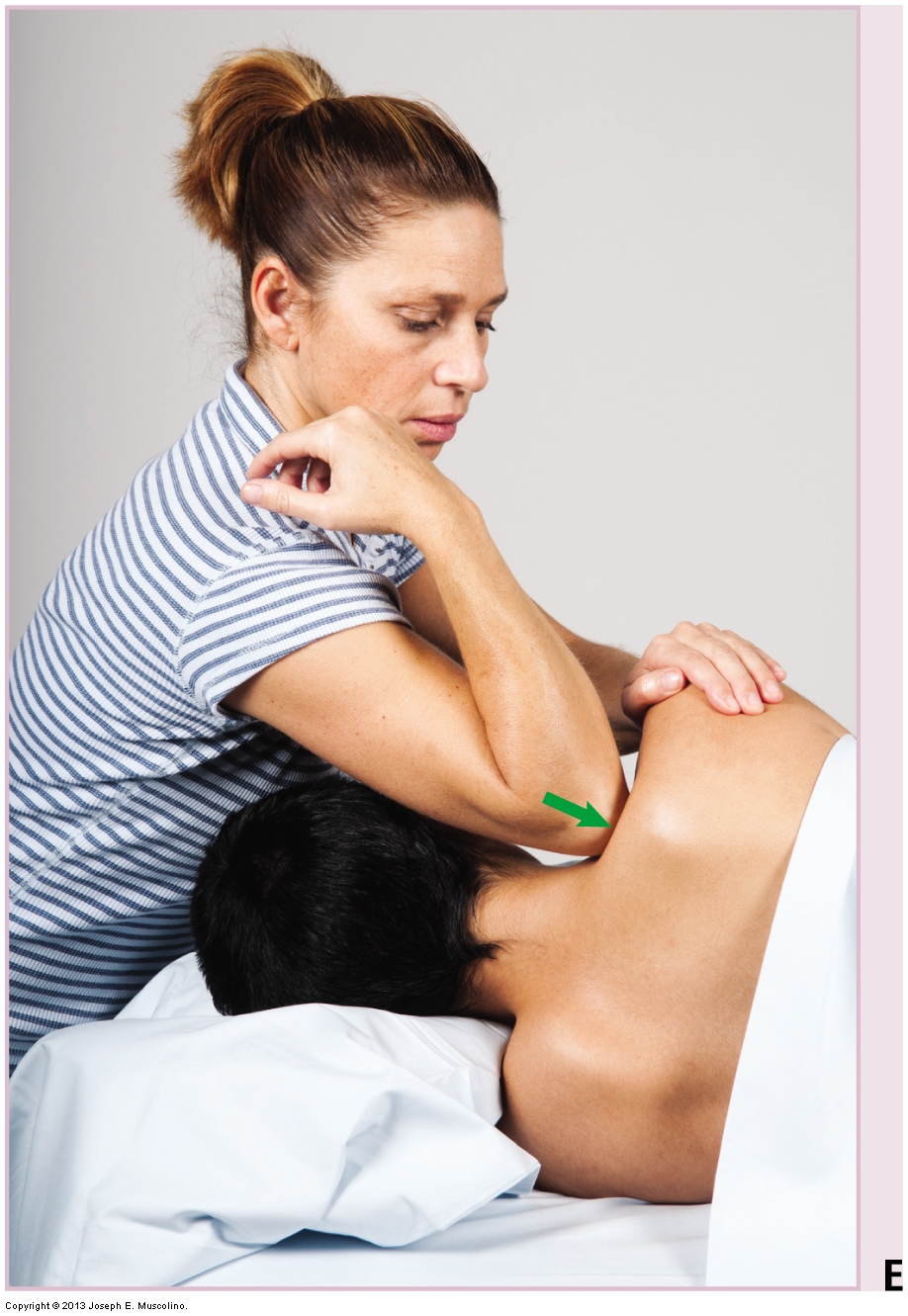This blog post article is the tenth in a series of ten articles on Deep Pressure Massage of the Neck
Positioning the Client Prone or Side-lying for Deep Pressure Massage into the Neck
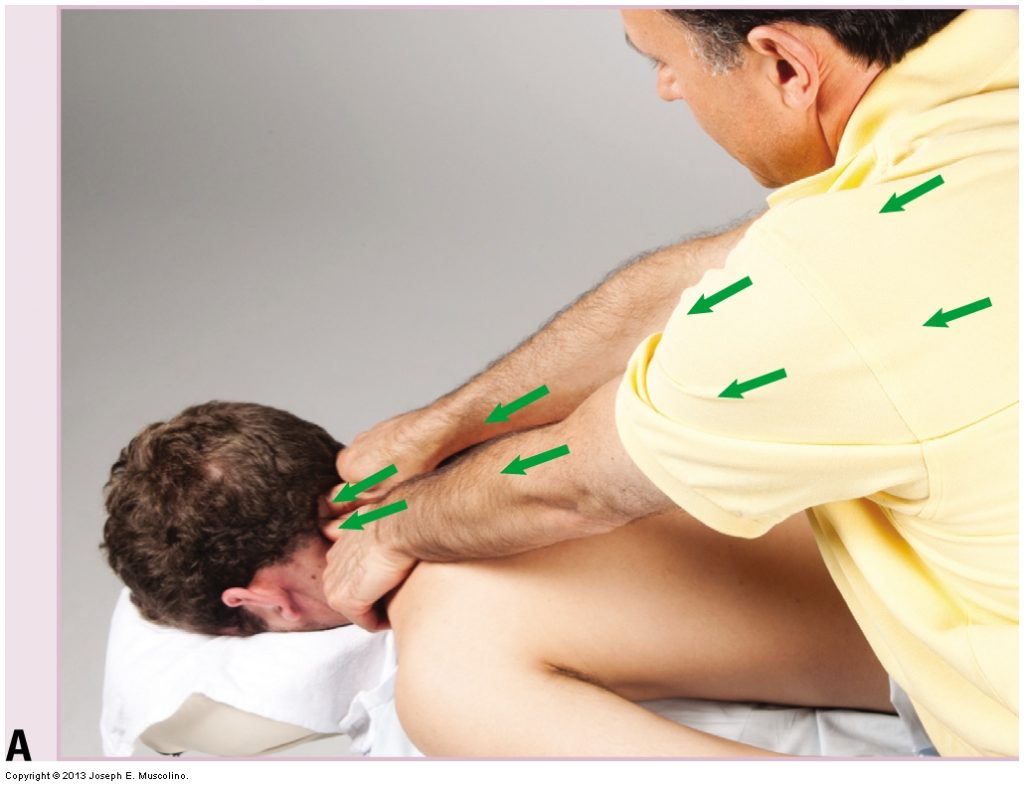
Prone and side-lying positioning. A, B, and C show prone work. (A) Working the upper neck. (B) Working the base of the neck/ upper trunk. (C) Using the elbow as a contact., D through F show side-lying work. (D) Thumb contact, working longitudinally along the length of the musculature. (E,F) Using the elbow as a contact; in (F) the client’s neck is being worked on stretch. (Note: The client’s neck is supported by her shoulder.) (G) Finger pad contact, working transversely across the musculature. Permission Joseph E. Muscolino. Advanced Treatment Techniques for the Manual Therapist: Neck (2013).
This series of blog post articles has demonstrated deep pressure massage to the posterior neck with the client supine. However, prone and side-lying work can also be done quite effectively, especially because these positions allow you to stand with your body over the client and use body weight to generate pressure.
When performing deep pressure massage to the middle and upper neck of the prone client, stand to the side of the table and be sure to direct your pressure superiorly along the client’s neck (horizontally and parallel to the floor) as well as deep into the tissues (Fig. A). This avoids unduly pressing the client’s face into the face cradle. It also creates somewhat of a stretching/tractioning force on the neck. This position is especially effective when working the upper neck and suboccipital region because it easily affords directing your pressure perpendicularly into the client. Massaging the upper and middle neck in the prone position is also logistically preferred when working on a client who has a hairline that extends further than usual down the neck. This is because strokes in the prone position are oriented inferiorly to superiorly, which does not tend to pull hairs; supine position strokes oriented superiorly to inferiorly do tend to pull hairs. Deep pressure massage to the base of the neck and upper trunk of the prone client is best done by standing at the head of the table so that pressure can be directed perpendicularly into the tissue (Fig. B). Elbow work can also be done with the client in the prone position if the therapist is small enough and/or the client is large enough to allow the therapist’s elbow to fit (Fig. C).
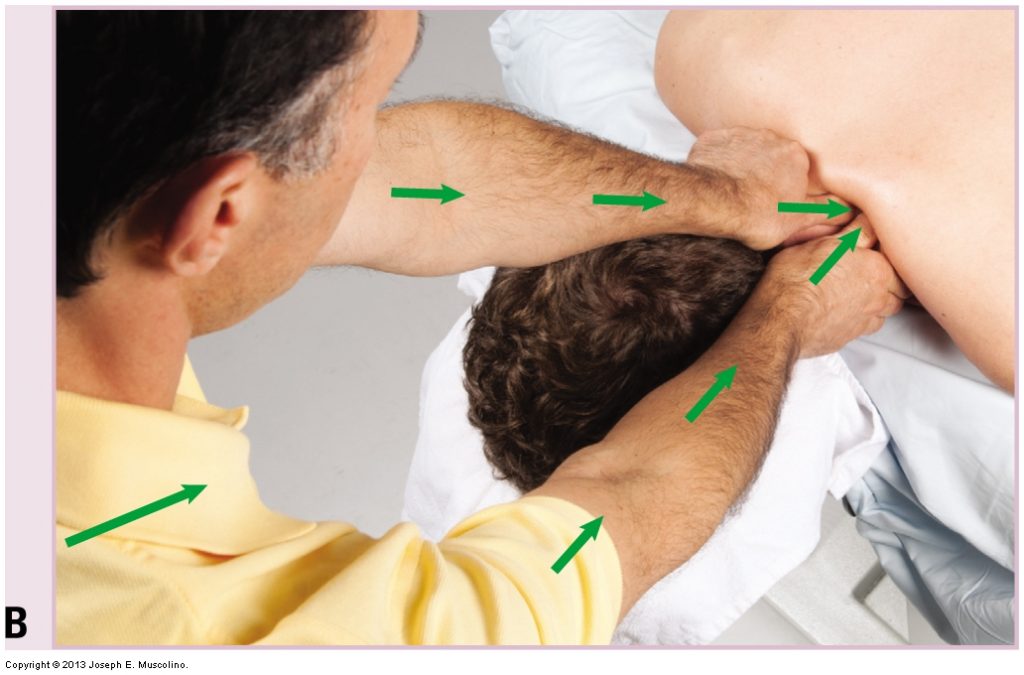
Figure B. Permission Joseph E. Muscolino. Advanced Treatment Techniques for the Manual Therapist: Neck (2013).

Figure C. Permission Joseph E. Muscolino. Advanced Treatment Techniques for the Manual Therapist: Neck (2013).
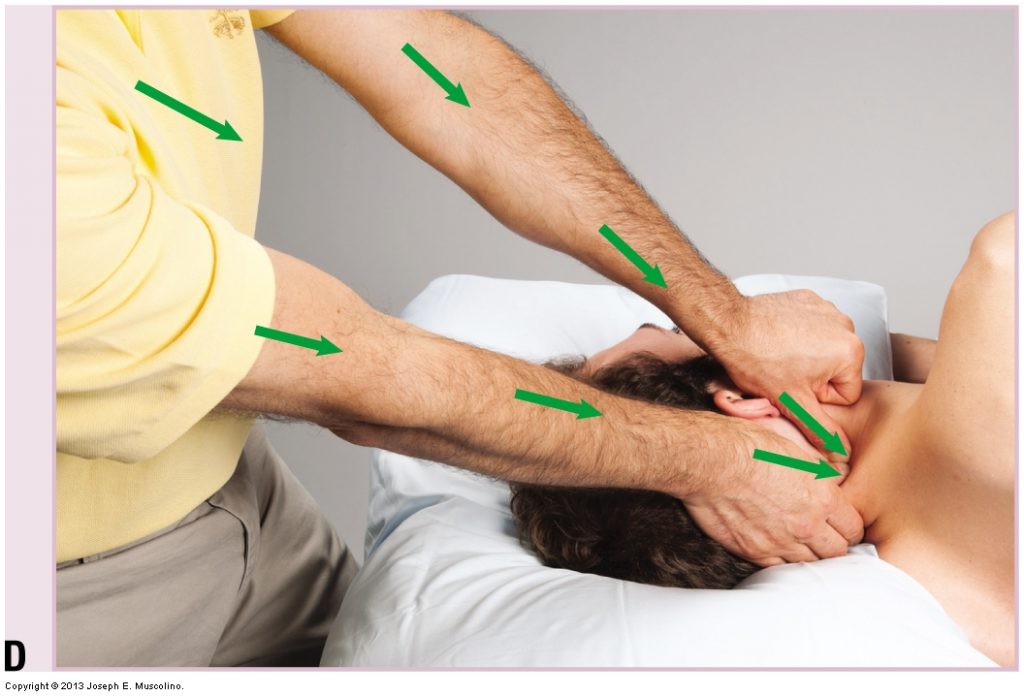
Figure D. Permission Joseph E. Muscolino. Advanced Treatment Techniques for the Manual Therapist: Neck (2013).
Side-lying position can also be very effective for deep pressure massage work into the neck and can allow for effective longitudinal strokes as well as transverse cross-fiber strokes. When performing deep pressure massage for the neck with the client side-lying, however, it is important to avoid exerting deep pressure too far anteriorly onto the transverse processes of the client’s neck. When using your thumbs as the contact in the side-lying position, it is best to stand at the head of the table and orient your strokes from superior to inferior. Be careful that the fingers of your anteriorly placed hand do not drape over and press on the front of the client’s neck; one way to avoid this is to flex the fingers of this hand (Fig. D).
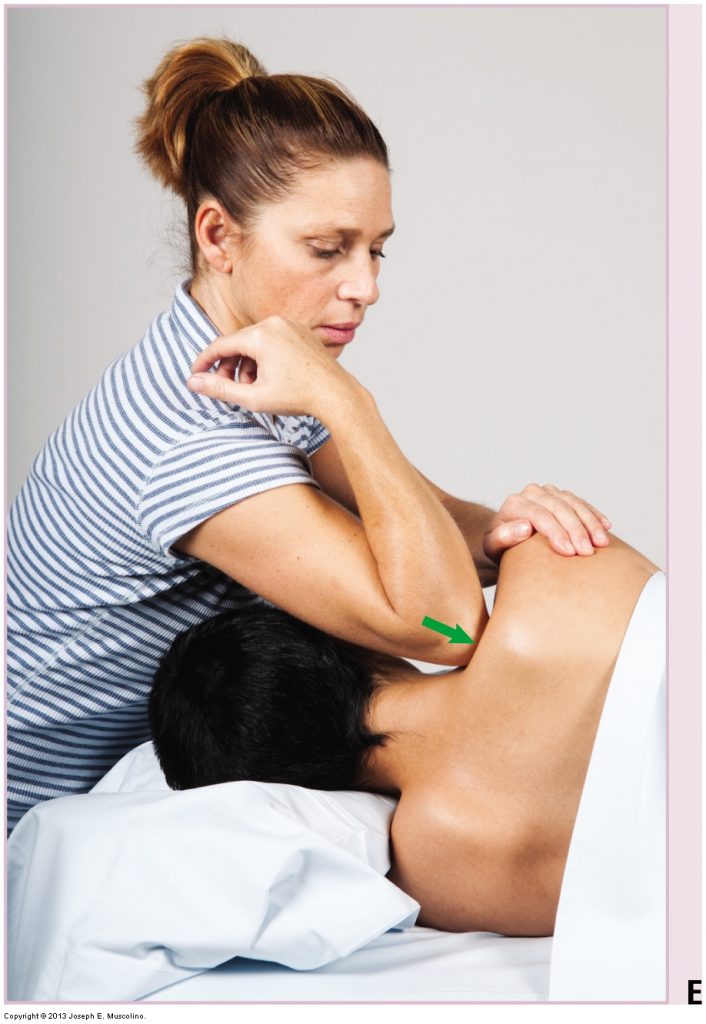
Figure E. Permission Joseph E. Muscolino. Advanced Treatment Techniques for the Manual Therapist: Neck (2013).
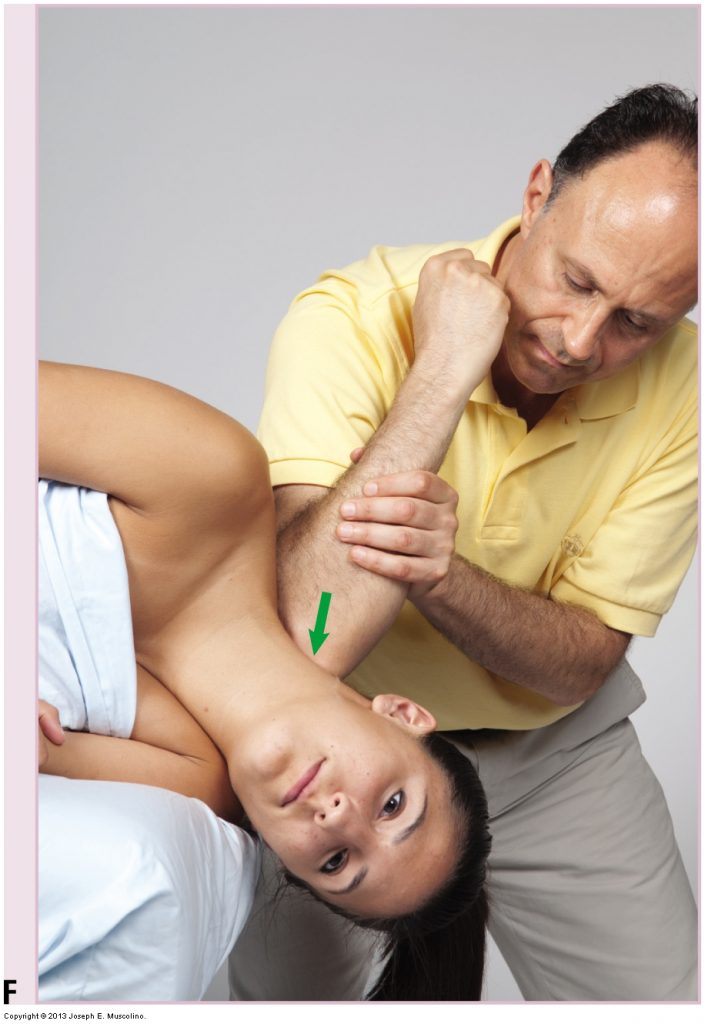
Figure F. Permission Joseph E. Muscolino. Advanced Treatment Techniques for the Manual Therapist: Neck (2013).
Note that the client’s neck is being supported by her shoulder. This is an “advanced technique.” See NOTE OF CAUTION below regarding the use of the elbow when working the neck.
Elbow work can also be done in this position if the ratio of the size of the therapist to the client allows for the therapist’s elbow to fit (Fig. E,F); again, strokes should be oriented longitudinally along the client’s neck.
NOTE OF CAUTION: When using the elbow for deep pressure massage, because it is a larger and potentially more powerful contact, caution must be exercised to not press too deeply into the client’s tissues; caution must especially be exercised to not slip and contact the client’s transverse processes. However, once you have good control over the use of your elbow, there is no reason that it cannot be used as a contact when working the neck. But you should be experienced and have good control before using the elbow as a contact here.

Figure G. Permission Joseph E. Muscolino. Advanced Treatment Techniques for the Manual Therapist: Neck (2013).
Side-lying deep pressure massage work also allows for very effective transverse friction across the client’s musculature. Stand to the side of the client; with curled fingers, grasp the musculature on the opposite side of the client’s body. Then lean back, using your body weight to pull your fingers into and across the client’s musculature (Fig. G). As with all side-lying work, be careful not to exert too much pressure on the transverse processes.
Note: Adding a Stretch to Deep Pressure Massage
The treatment technique demonstrated in this series of blog post articles show the deep pressure massage work to the neck with the client’s neck either in a neutral position with respect to lateral flexion, or laterally flexed toward the side that is being worked, shortening and slackening the musculature that is being worked. However, it can also be valuable to work the musculature while on stretch. To do this, the client’s neck is laterally flexed to the opposite side. The advantage to working a muscle on stretch is that it intensifies work into the more superficial musculature. The advantage to working a muscle that is shortened is that it slackens the more superficial musculature, allowing greater access to deeper musculature.
This blog post article is one of ten articles on Deep Pressure Massage Technique to the Neck.
The ten articles are:
- Introduction to Deep Pressure Massage Technique to the Neck
- Neck Deep Pressure Massage: Using Bodyweight and Muscular Effort
- Neck Deep Pressure Massage: Overview
- Neck Deep Pressure Massage: Step by Step – Positioning
- Neck Deep Pressure Massage: Step by Step – Contacts
- Neck Deep Pressure Massage: Step by Step – Use Your Core
- Neck Deep Pressure Massage: Step by Step – Apply Pressure Perpendiculary
- Neck Deep Pressure Massage: Step by Step – Engage the Tissues
- Neck Deep Pressure Massage: Step by Step – Deep Stroking Massage
- Neck Deep Pressure Massage: Prone and Side-Lying
(Click here for the blog post article: What is Whiplash and What are the Causes of Whiplash?.)


